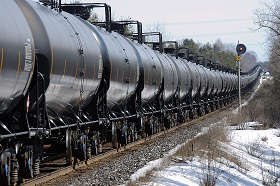EIA: Data shows trends for rail shipments of crude oil, ethanol and biodiesel

The US Energy Information Administration (EIA) recently expanded its rail data for crude oil, ethanol and biodiesel to provide monthly data going back to January 2010. The data encompasses rail movements within each Petroleum Administration for Defense District (intra-PADD) and between PADDs (inter-PADD), as well as rail movements to and from Canada. The expanded rail data improves EIA's regional supply and disposition balances by providing information about both shipments and receipts of these fuels by rail.
Most crude oil, ethanol and biodiesel rail shipments in the US originate in the Midwest (PADD 2). For ethanol and biodiesel, the volume of each fuel transported by rail aligns with production volumes, as rail is the primary mode used to transport these fuels.
Although crude oil is primarily transported through pipelines, the amount of crude oil shipped by rail increased from 2010 to 2014 as domestic crude oil production exceeded pipeline takeaway capacity for crude oil. The volume of crude oil transported by rail depends on many factors, including production volumes, price differences across crude oil types, netback value to the wellhead from alternative destination points, and availability of pipeline infrastructure. After reaching more than 1 MMbpd in 2014, crude-by-rail volumes declined slightly in 2015.
The origins, destinations and volumes of ethanol and biodiesel shipped by rail have not changed much over the past six years. Almost all ethanol and biodiesel ends up in the motor gasoline or diesel pools, respectively. The only other outlet for fuel ethanol or biodiesel is exports, which are relatively small compared with domestic consumption, making up 6% and 7% of the total ethanol and biodiesel volumes produced in 2015, respectively.
In 2015, the ethanol share of gasoline was 9.9%, and the biodiesel share of distillate was 2.4%. In 2015, the Midwest shipped 594 Mbpd of ethanol by rail and 17 Mbpd of biodiesel by rail. The East Coast (PADD 1) receives almost half of the ethanol shipped by rail. The volume of ethanol shipped by rail will likely change if more ethanol is blended into gasoline, but ethanol's share of the gasoline pool has been relatively steady at just below 10%.
Taken together, rail movements of crude oil, ethanol and biodiesel in the first three months of 2016 averaged 1.1 MMbpd, 19% lower than the 2013–2015 average. Ethanol and biodiesel rail shipments have been relatively flat, so the recent overall decline in transport of liquid fuels by rail reflects reduced rail shipments of crude oil.
Source: U.S. Energy Information Administration, Petroleum Supply MonthlyPrincipal. Contributor: Arup Mallik

- ExxonMobil halts 1-Bft3d blue hydrogen project in Texas
- Aramco and Yokogawa commission multiple autonomous control AI agents at Fadhili gas plant
- Ukraine will resume gas imports via Transbalkan route in November
- Mitsubishi to inject $260 MM into Brunei LNG project
- Freeport LNG (U.S.) on track to take in more natgas on Thursday after unit outage



Comments